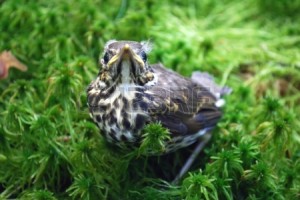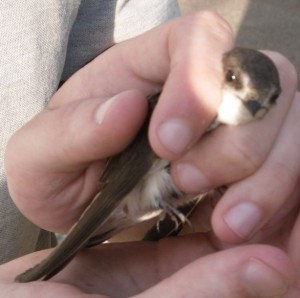Your Wildlife Garden Part 6 – Treating Injured Birds
With it fast approaching that time of year when you might stumble upon an apparently abandoned or doomed young bird in your garden, we thought it would be useful to finish the garden bird blogs by answering the questions, when is it ok to step in to help a bird and what’s the best way to do so?
Being caught, handled and treated is a very stressful experience for a bird, so it’s important to consider the benefits of doing so before you step in to help. A general rule to apply is; a injured bird can only be helped if it can be caught, so if it’s proving very difficult to catch then in most cases it’s not injured enough to require help. It’s also important to remember that just because a bird is on its own or in a place you wouldn’t usually expect to find it, this doesn’t automatically mean that it’s injured or in danger. A much more contentious issue, is when is it acceptable to pick up isolated juvenile birds that you find on your garden lawn? The surprising answer to this is, almost never. It’s perfectly normal for fledglings to leave the nest before they’re able to fly properly and it does more harm than good to interfere with them. It’s also unlikely that they have been abandoned by their parents, in most cases they will just be collecting food or will be sitting nearby keeping an eye on the juvenile. Another question that needs to be asked is, should you put a juvenile bird back into a nearby nest? There are three things to consider before you choose to do so 1) is the bird unfeathered or covered in down (unlike the fledgling pictured below), 2) does it seem fit and healthy and 3) do you know exactly what nest it came from? If the answer to all these questions is yes, then it’s ok to put it back in the nest. If the bird is covered in down and isn’t fully feathered yet then it’s not ready to be out of the nest (as opposed to a full fledgling) and can benefit from being placed back. All though it seems strange to not place a sick or injured juvenile back in the nest, it has probably been ejected from the nest by its parents due to its ill health and may simply be ejected again if you place it back. And regarding the third point, if you place a juvenile back in the wrong nest it will simply be ejected by the parents and will also interfere with the feeding of their own offspring.

So, now that you have decided that the juvenile or adult bird is sick or injured enough to warrant help what do you do now? Here’s a list of steps that should be followed to ensure the best treatment of the bird;
- Catch the bird quickly and correctly; Small birds should be caught firmly yet gently in one hand, letting its head poke out from between your first two fingers as seen in the image below. Larger birds should be caught in two hands, each grasping around a wing whilst making sure the bird is held out in front of you.
- Try to reduce any added stress or distractions; It’s stressful enough for a bird to be caught so try to prevent too many people from approaching and move it away from any sources of noise. It also helps to place a towel over the bird, preventing it from flapping, with the darkness also helping to calm it down. If the bird is visibly stressed this can also be done before it’s handled.
- Find a cardboard box or container to hold the bird; Find a suitably sized box (enough room for it to be comfortable but not large enough for it to flap about in and cause further damage) and poke holes in the side of it to aid ventilation. Make sure that the box is covered, once again the darkness will help to calm the bird down and is the best treatment for shock.
- Call a licensed wildlife rehabilition charity or centre; In Scotland the best charity to call is the SSPCA, whilst in England and Wales the equivalent is the RSPCA. In addition there may be independent wildlife rehabilitation centres in your local area whilst vet surgeries can also be called but are unlikely to come and pick the bird up. Although we can offer advice on how to care for injured or sick birds please only bring them into a Scottish Wildlife Trust centre as a last resort, as we don’t have the expertise or facilities to care for injured animals and can only call the SSPCA as you can do yourself.
- Continue to monitor the bird; When waiting for the bird to be picked up place the box in a quiet spot, preferably outside to provide ventilation and continue to monitor it (although not too frequently as it will further disturb the bird). It’s also best to refrain from feeding the bird as this is best left to trained wildlife handlers.

So by following these simple instructions you should now be better prepared for that moment you see a sick or injured bird whether it be on the beach, at the side of the road or in your back garden. Hopefully, by reading our 6 wildlife garden blogs you will have also gained the knowledge to go on to start or improve your own wildlife garden, providing the perfect habitat for garden birds to feed, nest and call home.
Craig Shepherd,
Visitor Centre Assistant Manager.
Help protect Scotland’s wildlife
Our work to save Scotland’s wildlife is made possible thanks to the generosity of our members and supporters.
Join today from just £3 a month to help protect the species you love.
Preface
With it fast approaching that time of year when you might stumble upon an apparently abandoned or doomed young bird in your garden, we thought it would be useful to …
